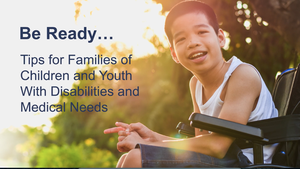- Summary of Activities
- Children and Youth with Special Healthcare Needs
- CONOPS: Leveling the Playing Field
- Exercises
- Family Reunification
- Hazard Vulnerability Analysis & Metrics Score Card
- Pediatric Disaster Education
- Pediatric Facility Preparedness
- Supply Chain
- Telehealth
- Workshops, Events & More
Be Ready: Tips for Families of Children and Youth with Disabilities & Medical Needs
Details

Families with children and youth with disabilities and medical needs are known to be some of the most vulnerable in a disaster. These families have fewer resources, and they require both community and health care provider support to achieve readiness.
When these families are disaster ready, they are less likely to suffer adverse consequences and are more resilient. The following toolkit of videos and accompanying infographics have been designed to meet to the diverse needs of the communities we serve.
Other Language Versions
English subtitles with voice over | American Sign Language (ASL) | Español (Spanish) |français (French) | عربي (Arabic) | Bấm để phát video này bằng tiếng Việt (Vietnamese) | kreyòl ayisyen (Haitian Creole) | 简单的中文 (simplified Chinese) | 中國人 (traditional Chinese) | 한국인 (Korean) | Tagalog
Resources

Be Ready Infographics: Tips for Families of Children and Youth with Special Healthcare Needs
Be Ready infographics provide a suite of information that can be used and distributed via print or social media. Each infographic covers the following key topics and is available in English, Spanish, French, Arabic, Chinese, Vietnamese, Tagalog and Haitian Creole.
The series contains eight infographics:
- Be Ready Awareness: Introduces families to the need to be prepared.
- Be Ready You Are the Help: Highlights the caregiver role in being disaster ready.
- Be Ready Do-It-Yourself Home Emergency Kit: A list of disaster supplies to have on hand.
- Be Ready When Disaster Strikes: How to respond when disaster strikes.
- Be Ready Shelter in Place: The why and how to shelter in place.
- Be Ready Stay Informed: How early alerts and notifications protect.
- Be Ready Evacuation: What to do in an evacuation.
- Be Ready Provider Teaching Checklist: Health care provider guidance on how to help families of disabled children be
Other Language Versions
español (Spanish) | français (French) | عربي (Arabic) | Tiếng Việt (Vietnamese) | kreyòl ayisyen (Haitian Creole) | 中国人 (simplified Chinese) | tagalog